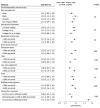Fine Particulate Matter, Its Constituents, and Spontaneous Preterm Birth
- PMID: 39535795
- PMCID: PMC11561696
- DOI: 10.1001/jamanetworkopen.2024.44593
Fine Particulate Matter, Its Constituents, and Spontaneous Preterm Birth
Abstract
Importance: The associations of exposure to fine particulate matter (PM2.5) and its constituents with spontaneous preterm birth (sPTB) remain understudied. Identifying subpopulations at increased risk characterized by socioeconomic status and other environmental factors is critical for targeted interventions.
Objective: To examine associations of PM2.5 and its constituents with sPTB.
Design, setting, and participants: This population-based retrospective cohort study was conducted from 2008 to 2018 within a large integrated health care system, Kaiser Permanente Southern California. Singleton live births with recorded residential information of pregnant individuals during pregnancy were included. Data were analyzed from December 2023 to March 2024.
Exposures: Daily total PM2.5 concentrations and monthly data on 5 PM2.5 constituents (sulfate, nitrate, ammonium, organic matter, and black carbon) in California were assessed, and mean exposures to these pollutants during pregnancy and by trimester were calculated. Exposures to total green space, trees, low-lying vegetation, and grass were estimated using street view images. Wildfire-related exposure was measured by the mean concentration of wildfire-specific PM2.5 during pregnancy. Additionally, the mean exposure to daily maximum temperature during pregnancy was calculated.
Main outcomes and measures: The primary outcome was sPTB identified through a natural language processing algorithm. Discrete-time survival models were used to estimate associations of total PM2.5 concentration and its 5 constituents with sPTB. Interaction terms were used to examine the effect modification by race and ethnicity, educational attainment, household income, and exposures to green space, wildfire smoke, and temperature.
Results: Among 409 037 births (mean [SD] age of mothers at delivery, 30.3 [5.8] years), there were positive associations of PM2.5, black carbon, nitrate, and sulfate with sPTB. Adjusted odds ratios (aORs) per IQR increase were 1.15 (95% CI, 1.12-1.18; P < .001) for PM2.5 (IQR, 2.76 μg/m3), 1.15 (95% CI, 1.11-1.20; P < .001) for black carbon (IQR, 1.05 μg/m3), 1.09 (95% CI, 1.06-1.13; P < .001) for nitrate (IQR, 0.93 μg/m3), and 1.06 (95% CI, 1.03-1.09; P < .001) for sulfate (IQR, 0.40 μg/m3) over the entire pregnancy. The second trimester was the most susceptible window; for example, aORs for total PM2.5 concentration were 1.07 (95% CI, 1.05-1.09; P < .001) in the first, 1.10 (95% CI, 1.08-1.12; P < .001) in the second, and 1.09 (95% CI, 1.07-1.11; P < .001) in the third trimester. Significantly higher aORs were observed among individuals with lower educational attainment (eg, less than college: aOR, 1.16; 95% CI, 1.12-1.21 vs college [≥4 years]: aOR, 1.10; 95% CI, 1.06-1.14; P = .03) or income (<50th percentile: aOR, 1.17; 95% CI, 1.14-1.21 vs ≥50th percentile: aOR, 1.12; 95% CI, 1.09-1.16; P = .02) or who were exposed to limited green space (<50th percentile: aOR, 1.19; 95% CI, 1.15-1.23 vs ≥50th percentile: aOR, 1.12; 95% CI, 1.09-1.15; P = .003), more wildfire smoke (≥50th percentile: aOR, 1.19; 95% CI, 1.16-1.23 vs <50th percentile: aOR, 1.13; 95% CI, 1.09-1.16; P = .009), or extreme heat (aOR, 1.51; 95% CI, 1.42-1.59 vs mild temperature: aOR, 1.11; 95% CI, 1.09-1.14; P < .001).
Conclusions and relevance: In this study, exposures to PM2.5 and specific PM2.5 constituents during pregnancy were associated with increased odds of sPTB. Socioeconomic status and other environmental exposures modified this association.
Conflict of interest statement
Figures

References
-
- World Health Organization . Preterm birth. Updated May 10, 2023. Accessed October 8, 2024. https://www.who.int/news-room/fact-sheets/detail/preterm-birth
-
- World Health Organization . Child mortality (under 5 years). Accessed March 3, 2024. https://www.who.int/news-room/fact-sheets/detail/levels-and-trends-in-ch...
Publication types
MeSH terms
Substances
Grants and funding
LinkOut - more resources
Full Text Sources

